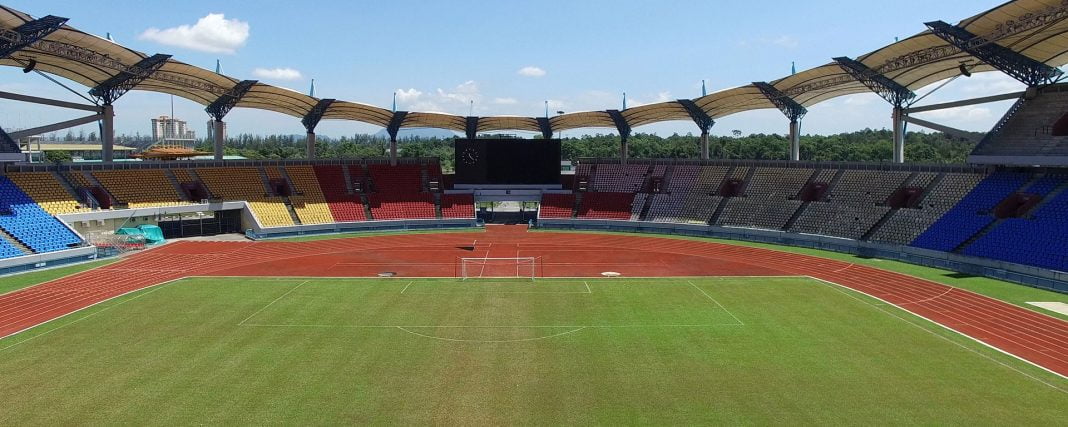By 2024, Sarawak aims to become the nation’s sports powerhouse.
Thus, this requires good the State to strengthen its sports infrastructure.
Sport infrastructure encompasses facilities, systems, goods and services that enable the sport and leisure.
They may include those such as stadiums, sports halls, swimming pools, fitness facilities, ski resorts, golf courses and other sports infrastructure.
Creating a healthier society
“Today, sports have emerged as an important component of socio-economic development of a state,”
“The people’s active participation in sports and games will improve community health and productivity, reduce medical expenses, imbibe discipline in character, generate great leaders, and enhance social cohesion,” said its minister, YB Datuk Haji Abdul Karim Rahman Hamzah in his winding up speech of DUN sitting on 7th May 2019.
The development of sports infrastructure encourages the young population to participate in sporting activities and thus contributes to a healthier society.

Skills and abilities developed by sport promote people’s well-being and has direct impact on their physical, mental and psychological performance, hence better quality of life.
So, in order to encourage the society to live a more health-conscious way and pursue more sports, providing proper infrastructural background is also crucial as motivation and providing health education is not enough.
Social advantages of sports infrastructure
Aside from health benefits, sport infrastructural investments and developments brings various and long-term impacts which includes social advantages.

In terms of social, the establishment of sports infrastructures act as bridges that connects various communities and improve social cohesion.
The Australian Institute of Criminology also acknowledged that the role of physical activities especially sports can prevent or reduce crimes and anti-social behaviours including substance abuse, suicide or self-harm, unemployment and mental health.

The participation of youths in sports activities also helps build strong relationships among teammates.
This is because the social support helps them feel connected to their communities thus fostering a sense of belonging.
Aside from that, sports tend to motivate the youths to bring the discipline and motivation through sports to the academic field. They can also rely on the resilience from sports-related challenges to overcome any work and personal hurdles.
Economic benefits of sports infrastructure
Aside from health and social benefits, sports infrastructure also have its economic benefits.

Events that are held at local sports infrastructure deliver economic benefits to local community, especially from tourism expenditure related to visitors brought to the community through the events and also from the activities generated from the participation of the community in the infrastructure.

In recent years, Sarawak has hosted several major sports events such as SUKMA or international sports, thus the need to have a world-class sports infrastructure.

In addition to this, the number of people employed through the investment and development of sports infrastructures supports employment and the economy.
“The organising of sporting events will also help in developing infrastructure, generate employment, secure inflow of foreign capital, and thus contributes significantly to the economic development of a state,” said YB Datuk Abdul Karim in his 2019 DUN winding-up speech.
Under the 11th Malaysia Plan, 17 projects with an allocation of RM150 million were approved for upgrading works for sports complexes and mini stadiums.
- Betong Swimming Pool Complex (RM12.5 million)
- Kem Belia Pueh (RM5 million)
- Kem Belia Kemuyang (RM5 million)
- Kem Belia Mukah (RM5 million)
- Upgrading of Sarikei Sports Complex (RM4 million)
- Upgrading of Kapit Sports Complex (RM4 million)
- Repair Works to Miri Sports Complex (RM6million)
- Upgrading of Kanowit Sports Complex (RM3.5 million)
- Simunjan Sports Complex (RM2.55 million)
(Source: Minister for Youth and Sports Sarawak YB Datuk Haji Abdul Karim Rahman Hamzah, 7th May 2019)
Under this environment, State athletes can focus on their training and will be well prepared physically and mentally when participating in major sporting events such as the Malaysia Games (Sukma), SukSAR (Sarawak Games or Sukan Sarawak) or international sports events.
YB Datuk Haji Abdul Karim also noted that Sarawak is in need of a high-performance sports centre if it wants to be known as a sports powerhouse by 2024.
The proposed projects under the 12th Malaysia Plan for sports infrastructure includes:
(a) High Performance Sports Centre at Petra Jaya, Kuching;
(b) Sarawak F1 Go-Karting Circuit at Petra Jaya;
(c) Velodrome at Petra Jaya, Kuching;
(d) The Skeet & Trap, and Pistol Range at Sarawak Shooting Range, Petra Jaya, Kuching;
(e) LED Lighting System for Stadium Sarawak, Stadium Negeri, Padang C, Padang D and Street Lightings at Petra Jaya, Kuching;
(f) Sarawak Sports Museum at Petra Jaya, Kuching;
(g) Upgrading of Stadium and Sports Facilities to Smart Stadium Concept at Petra Jaya, Kuching;
(h) The upgrading of Running Track at all Stadiums in Sarawak;
(i) Upgrading of Hostel at Bukit Lima, Sibu to Majlis Sukan Negeri Sarawak;
(j) Artificial Hockey Field Turf at Sibu and Miri; and
(k) Kapit Sports and Convention Centre
“Despite the COVID-19 pandemic, the Ministry has managed to implement 361 programme this year with a total of 27,173 participants and the Projek Rakyat and RMK11, the Ministry has allocated RM365 million to undertake the development of 42 sports facilities throughout the State,”
“The Ministry will continue to provide more conducive sports facilities and organize more programme to develop our youth,”
This was said by the Deputy Chief Minister, YB Datuk Amar Awang Tengah Ali Hassan on behalf of YB Datuk Abdul Karim when delivering his winding speech at the Dun sitting on 13th November 2020.
As Sarawak aims to become the national’s sports powerhouse in the near future, investing in the development of sport infrastructure ensures the State will achieve the objective sooner than expected.






